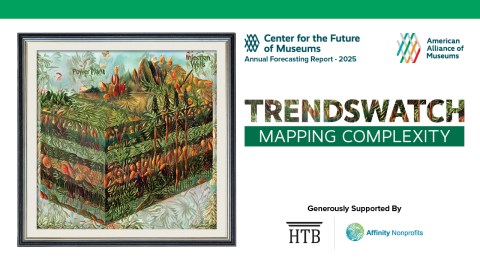Earlier this month I participated in a very interesting scenario planning exercise at the Smithsonian. The session was led by Peter Schwartz, a board member from the Long Now Foundation, an organization whose mission is “to creatively foster responsibility in the framework of the next 10,000 years.” Now there is long-range planning to aspire to! Guiding us through two days of thought about the future, Peter emphasized that one weakness of scenario planning is people’s tendency to take certain things for granted. This makes it is tremendously important to recognize and question the assumptions we make about our organizations and museums in general.
Since CFM encourages museums to use scenario planning as part of their suite of planning tools, I want to begin an ongoing conversation about what museums often take for granted about their world. Here goes—I’ll start, and you weigh in.
Let’s start with the assumption that museums are already beginning to question:
Everything in the collections stays in the collections
Barring unfortunate circumstances (whale ovaries that prove to be at risk of exploding, material that inconveniently proves to have been illegally expropriated from its country of origin, the need to sell one Dutch master painting to afford an even better one) once an object entered the collections, it used to be presumed it should stay. Forever. The field is already revisiting this issue, if only due to the belated realization that collections storage is both finite and expensive. About seven years ago the Accreditation Commission instigated a national discussion on the need to engage in collections planning–the process of shaping the collection in a coordinated and uniform direction over time to refine and expand the value of the collection in a predetermined way. Now there is wide acceptance that having a collections plan is a best practice, and it is well on its way to evolving into a standard (something all good museums are expected to do.) That may make museums look, and operate, very differently in the future.
Everything that fits the plan goes into the collections
What is the next logical challenge to the collecting paradigm? Perhaps in the future, there may be many alternatives to the “permanent” collection owned by and residing in the museum for the indefinite future. Are there collections that museums might consciously acquire for a finite period, and then pass along (into or out of the public domain) when they are no longer of use to their community of users? Might museums increasingly “curate” (identify, track, research, conserve and interpret) material that never enters their collections at all? Which museums like the Richmond History Center, Historic Annapolis and others already do, in effect, when they make whole neighborhoods extensions of their museums.
Growth is good, necessary and inevitable
Museums can hardly be faulted for embracing this value, which I think underpins the whole American way of life. How many directors and board chairs see the pinnacle of their achievement as being the capital campaign funding the museum’s new building or expansion? This is so ingrained in our thinking that even the Isabella Stewart Gardner Museum is jumping on the growth wagon, and they have as unimpeachable excuse as a museum ever had for NOT expanding. In fact, they had to go all the way to the Supreme Judicial Court of Massachusetts to determine it did not violate their founder’s intent in order to do so.
For a variety of reasons society as a whole is beginning to question whether growth is good and inevitable, or whether it is even sustainable. Taken to its logical extreme, it is obvious that of course, it is not. Any system (ecological, financial or other) has a maximum carrying capacity. Sometimes we find a way to temporarily expand the pie (for example, increasing crop yields by using nitrogen-based fertilizers—in essence, spending solar energy that had been banked for millions of years as fossil fuels.) But in the end, we reach the limits of these new resources as well. We as a nation are contemplating what our society will look like, post-peak oil production. And this year we are wondering how many of our financial systems were, in effect, Ponzi schemes that created an illusion of sustainable growth. As a species, we need to assess the world’s carrying capacity and create an economy in equilibrium with basic ecological support systems. As we do so, America and American museums will explore the rational limits to our growth and learn what it means to live within a steady-state economy, rather than one premised on unending growth. How do we reward organizations and individuals for sustaining a museum at the same, right size for decades? Or even celebrate a good decision to downsize it in response to changes in the community? Which is a good segue to the next assumption…
Museums as organizations tied to a particular place
On an historical timescale human populations have always been transient, and in this century the rate of migration may accelerate, driven by ecological, economic and political forces. Museums, anchored to their large, expensive buildings, their historical communities and their sense of identity, traditionally behave as if they are fixed and immovable. How do we reconcile these conflicting behaviors? Will the Detroit Institute of Arts continue to be a bastion of culture in a city that continues to decline in wealth and population? Who will support it? Who will it serve? Can it actually contribute to the revitalization of Detroit, to a scale comparable with its glory days of the auto industry? Does it face a future in which it downsizes to fit the needs and resources of a much-reduced city? Or does it pick up stakes and move to a swelling population center that wants and can support an institute of its quality? If the majority of the population of New Orleans relocates to Houston in the next decade, should the New Orleans Museum of Art follow, and in order to continue to serve the community that built it?
Museums will always be tax-exempt nonprofits
We are living in a world turned upside-down. Newspapers, in economic freefall, are closely watching their compatriot Mother Jones and considering going non-profit. Now that newspapers’ traditional economic model of using advertising revenue to subsidize investigative reporting is busted, they are considering our model—finding people who value a service that provides a general good to society (in this case, acting as a watchdog on business and government)—and asking them to underwrite it. “Why should you support us?” Mother Jones asks. “Because “smart, fearless journalism” keeps people informed–”informed” being pretty much indispensable to a democracy that actually works.” Other services that have traditionally been delivered through nonprofit NGOs are exploring a for-profit business model, finding that it does their good work more effectively. For example, the Africa Netmark regional project teams the nonprofit Academy for Educational Development with the S.C. Johnson Company (a multinational for-profit producer of insect-control products) to distribute pesticide-treated materials to combat malaria. There are already a handful of for-profit museums (the International Spy Museum, the Newport Aquarium, the Museum of Sex.) What can we learn from their economics? What do they do (or not do) differently from nonprofit museums? Might organization, in the future, unbundled “profitable” functions such as exhibits from functions such as collections care, research, conservation that, like investigative reporting, are valued public goods and lodge them in separate organizations?
Your turn! What basic assumptions underpinning decisions made by your organization, or the field as a whole, bear reexamination in the future?









First of all, thank you for this blog and for raising such difficult issues.
At the moment, I don’t have any additional assumptions to question, just comments on the assumptions that you raised–all of which I think are completely valid and must be re-examined.
However, what is not mentioned in this post is what effect questioning these assumptions may have on the museum field. For example, several of the assumptions you list directly address museum collections and hence the role of the collections professional. Museum studies programs seem to be blossoming all over the country and all of them teach some form of collections management practices–practices that could be significantly altered or possibly even obliterated were museums to shift to an alternative approach to collecting and collections management. What then would happen to all of the current collections professionals as their skills become increasingly obsolete? I realize that this is a very specific concern and one that is perhaps too short-sighted and narrowly focused–we must look at the survival of museums as a field rather than any one particular individual.
But what of museums as a field? Right now one of the key functions of AAM is the accreditation of museums. But again, the basis of accreditation is heavily based on collections care and would need to be completely re-thought. So what then of all those museums that have been accredited in the past according to AAM’s current standards? What happens to them when the criteria for accreditation suddenly changes dramatically? Will the result be huge numbers of museums that fail to be re-accredited as they scramble to live up to a new and somewhat foreign set of standards?
I imagine that this all sounds somewhat alarmist. I am not actually against challenging long-held assumptions. But I think when we do, we need to also think about time-frames and how to help the people of the museum field move forward into the future along with the institutions themselves.
One more thought regarding unlimited growth. Obviously this idea is a fallacy–look where it got our stock market. But I think one of the reasons, aside from mere personal vanity on the part of directors or major donors, is the very real fear of loss of funding. Funders (governmental or private) want to see growth. What’s more, they want to see measurable growth. Grants often come with specific metrics they want to see–did you teach more students? did you offer more programs? So how do we convince our funders that it is quality rather than quantity that they should be supporting? How do demonstrate this through metrics?
This is a terrific list, Beth, and you’ve done a service just by reminding us that collections — oh right, those objects around which museums have traditionally been conceived — are still worth thinking about in these days of excitement about participation and socially networked experiences.
I’m glad you included the growth-is-good mantra in your list of assumptions to be questioned. That’s something my colleagues at the University of Chicago’s Cultural Policy Center are also doing: they’re starting a large national study of the scope and effects of the building boom in museums, concert halls, etc. over the last decade or so. The study is being led by some really interesting scholars in cultural economics, philanthropy, and decision-making, and it’s funded (generously) by the MacArthur, Mellon, and Kresge Foundations. Look here
for a brief description.
I would add to your list a few assumptions about museums’ audiences, starting with the idea that museums are meant to serve the broad populations in their areas. Although few museum people acknowledge it, in practice they’re trying to make their institutions for everybody — a few things to all people. The inability to focus on specific audiences (except through particular education programs or small temporary exhibits) is part of what makes most museums feel so generic and, well, institutional…even many small ones. The irony, of course, is that very few museums actually do serve all kinds of people (the Te Papa Museum in Wellington, New Zealand is the only large museum I’ve heard of whose visitor demographics match those of its national population.) But just trying to do so changes the whole vibe of the place.
One doesn’t have to look far afield for examples of nonprofit and for-profit organizations that serve narrow niches more deeply: more things for some people. This makes possible a stronger, clearer sense of affiliation among the people for whom the thing is really designed. Sure, museums are public goods, but we’ve historically assumed that each one needs to serve its community widely rather than that in aggregate they should do so. Actually, your point about for-profit and hybrid alternatives might open up this audience question further, and to good effect. What if the museum ecology of the future includes institutions that narrowcast rather than broadcast? What could they accomplish — get away with? — that today’s museums, because of their own self-definitions, cannot?
I thought Allyson’s point was excellent regarding funders’ needs to see growth. Part of challenging our own assumptions is challenging the assumptions of our funders (whether we be non-for-profit or for-profit…). Museums could argue for measurable “change” not measurable “growth”.
And I was happy to read Peter’s point. It is very (VERY) difficult to convince museums that even when they say they are for “everyone” they are not really for everyone. To be for the interest of some but not for the interest of others does not equate “keeping-others-out”. I do not believe museums recognize the distinction.
I would agree with Peter that the assumption that museums serve “everyone” will change. This is a corollary to the assumption that museums are about collections and the collections are for everyone. By shifting the focus to thinking about museums as places that serve communities–whether they be geographic, ethnic, or special interest (which is what Te Papa does)–we may begin to see a real change in how communities value and support museums.
As a policy person a heart I just had to add a quick comment. The discussion about shifting the focus to thinking about museums as places that serve communities–whether they be geographic, ethnic, or special interest (which is what Te Papa does)– to see a real change in how communities value and support museums reminded me of the whole political system of “Majority rule, minoirty rights.”